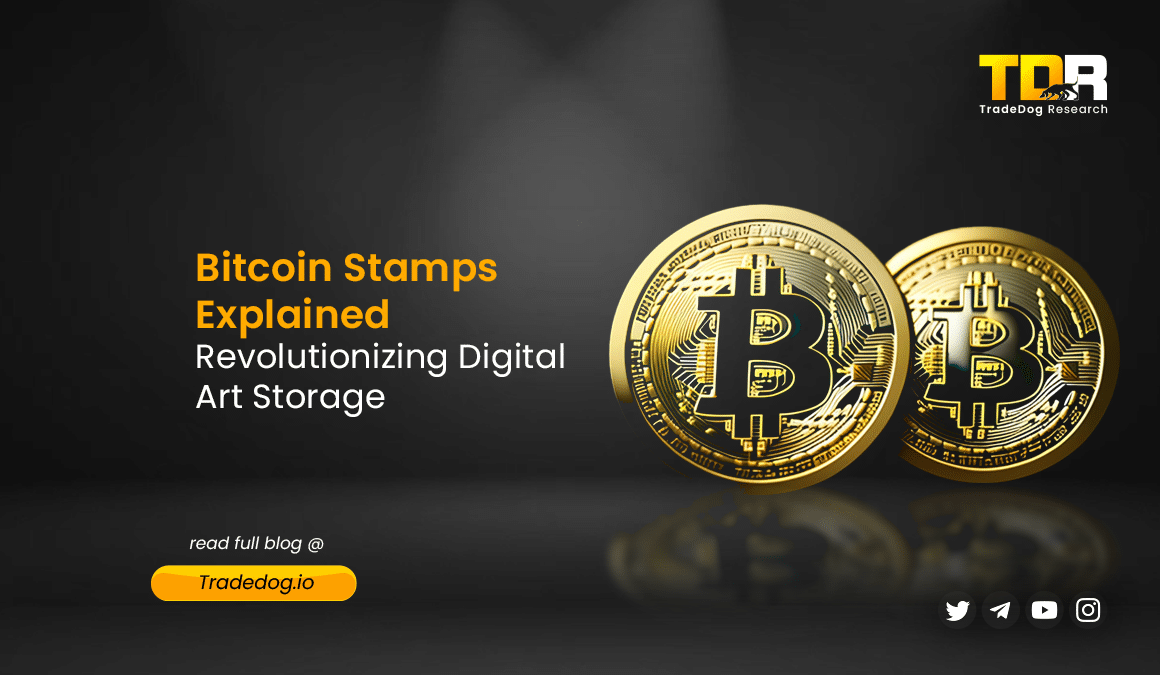Quick Links
The world of Bitcoin continues to evolve beyond its initial purpose as a decentralized currency. One recent innovation is Bitcoin STAMPS, a protocol that allows users to embed digital art directly onto the Bitcoin blockchain. Introduced in March 2023 by developer Mike In Space, it has emerged as a solution to limitations identified in earlier methods for storing data on the Bitcoin blockchain. Bitcoin STAMPS boast over ~ 4.2K unique holders and a staggering accumulated minted value exceeding ~ $1.4 billion. These figures paint a picture of a burgeoning technology poised to revolutionize digital art ownership.
Source – Stampscan
What are Bitcoin Stamps?
Bitcoin Stamps are essentially digital art pieces embedded directly into the Bitcoin blockchain. The protocol achieves this by encoding data within unspent transaction outputs (UTXOs). This embedded data becomes immutable and permanently inscribed on the blockchain. The creation of a Bitcoin Stamp involves transforming a piece of digital art into a base64 string, a format suitable for storage within the blockchain.
This string is then incorporated into a Bitcoin transaction, marked with a distinct “STAMP:” prefix. To ensure permanence, the data is spread across multiple outputs using multi-signature transactions. Each Bitcoin Stamp is assigned a unique number based on the transaction timestamp, facilitating chronological arrangement. For a Stamp to be recognized as valid, it must adhere to specific criteria, including possessing a valid “STAMP:base64” string within its description key.
Protocols Powering Bitcoin Stamps
SRC-20
Inspired by the Ethereum ERC-20 standard, SRC-20 enables the embedding of arbitrary data within spendable data transactions on the Bitcoin blockchain. Unlike Ordinals, which store data in the witness section, SRC-20 leverages the Counterparty protocol for direct transmission of text data onto the Bitcoin chain. Additionally, the “STAMP:” prefix and base64 encoding mechanism aid in recognizing these transactions as Pay-to-Script-Hash (P2SH). P2SH transactions empower users to design Bitcoin transactions that unlock funds only when specific conditions, outlined in a script, are met.
SRC-721
The SRC-721 standard caters to the creation of high-quality images by facilitating cost-effective storage of detailed NFTs. It accomplishes this by leveraging the Bitcoin Stamps protocol to layer images, enabling the use of methods like indexed color palettes for each layer to reduce file size. These layers can then be combined to form a single NFT, allowing for the creation of high-resolution images without incurring high costs.
How Do Bitcoin Stamps Work?
The process of creating a Bitcoin Stamp involves several steps:
- Data Conversion: The digital artwork is first converted into a base64 encoded format, a text-based representation that can be seamlessly integrated into Bitcoin transactions.
- UTXO Embedding: The encoded image data, along with additional metadata about the artwork, is embedded within unspent transaction outputs (UTXOs) of the Bitcoin blockchain. This ensures immutability, as the data becomes an inseparable part of the blockchain ledger.
- Transaction Creation: A new transaction is created on the Bitcoin network, containing the encoded data and any relevant metadata.
- Transaction Confirmation: The transaction is broadcast to the network and undergoes mining for confirmation. Once confirmed, the Bitcoin Stamp is permanently inscribed onto the blockchain.
- Verification and Accessibility: Anyone using the Bitcoin blockchain can verify the newly minted Bitcoin Stamp. Users can access information about the artwork and its ownership.
For those who don’t wish to mint their Stamps, several platforms facilitate buying and selling these digital collectibles. These platforms, like OpenStamp, Rare Stamp, and Stampscan, function similarly to traditional NFT marketplaces, allowing users to browse collections, view details of individual Stamps, and participate in buying and selling activities.
Bitcoin Stamps vs. Ordinals
While Bitcoin Ordinals are also a method for inscribing data onto the Bitcoin blockchain, there are a few key differences:
- Immutability: Bitcoin Stamps store data within UTXOs, making it resistant to the data pruning process that can occur with Ordinals stored in witness data. This ensures the permanent preservation of Bitcoin Stamps.
- Data Size and Cost: Bitcoin Stamps offer more flexibility in data size, allowing for higher-resolution images compared to Ordinals. However, this flexibility can lead to higher transaction fees.
- Security: Bitcoin Stamps leverage a multi-signature framework, enhancing data security compared to the single-signature system used by Ordinals.
- Network Impact: The way Ordinals store data can potentially lead to network congestion due to the larger data size. Bitcoin Stamps aim to minimize their footprint on the network.
Strengths and Opportunities
Immutable & Verifiable Ownership
Bitcoin Stamps provide a permanent and verifiable record of ownership for digital art stored directly on the Bitcoin blockchain. This eliminates the risk of manipulation or loss of ownership records, fostering trust and transparency within the art market. Collectors can be confident of the authenticity of their artwork, and artists can benefit from a secure way to track ownership and provenance.
Expanded Artistic Scope
The SRC-721 standard enables the creation of high-resolution images on Bitcoin Stamps. This opens doors for a wider range of digital art to be represented on the blockchain, encompassing everything from detailed paintings to intricate sculptures. Previously, limitations in data size might have restricted the type of digital art that could be stored. Now, artists can express themselves more freely and collectors can acquire a broader variety of digital artworks.
Challenges and Considerations
Transaction Fees
Minting a Bitcoin Stamp involves a transaction fee on the Bitcoin network. These fees can be significant, especially for artists working with high-resolution artwork that requires more data storage. This can be a hurdle for emerging artists or those creating complex pieces. As Bitcoin transaction fees fluctuate, managing these costs will be an ongoing consideration.
Early Stage Technology
Bitcoin Stamps are a relatively new technology. While the core functionality exists, wider adoption and development of user-friendly tools and infrastructure are needed. Platforms for creating, managing, and trading Bitcoin Stamps need to become more user-friendly and widely available to attract a larger user base. This includes tools for artists to easily mint their work, marketplaces for collectors to buy and sell Stamps, and wallets that seamlessly integrate with the Bitcoin Stamps ecosystem.
Outlook
Despite the current challenges, Bitcoin Stamps hold immense potential for revolutionizing digital art storage. As the technology matures and transaction fees become more manageable, Bitcoin Stamps are likely to gain wider adoption from artists, collectors, and the art market as a whole. The ability to own a verifiable and immutable piece of digital art on the secure Bitcoin blockchain offers a unique value proposition for the future of digital art ownership. With continued development and wider adoption, Bitcoin Stamps have the potential to become a prominent player in the digital art landscape.









